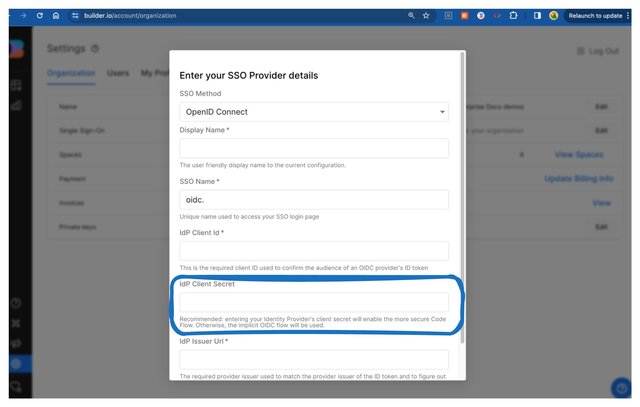OpenID Connect (OIDC) builds on OAuth 2.0 so applications can authenticate users and retrieve their basic information in a standardized way. OAuth 2.0 supports different authorization strategies, including:
- Implicit flow: for browser-based apps. It is less favored as it can expose tokens to the browser.
- Authorization Code Flow: is preferred for its security, suitable for apps that can manage a Client Secret without exposing it, as it conducts token exchanges away from the user's browser. The Client Secret acts as a password between the app and the authorization server to safely exchange an authorization code for an access token.
When setting up OIDC for SSO in Builder.io, you have the option to include a client secret in your Builder SSO configuration, which indicates that you want to use the code flow. If you don't include a client secret, Builder defaults to using the implicit flow.
Before starting, make sure you have already set up SSO. For detailed instructions, read one of the following documents:
- SSO with Builder and Your Identity Provider: this is a general document that shows an IdP-agnostic workflow for setting up SSO with Builder.
- SSO with Microsoft Entra ID: covers steps specific to Microsoft Entra ID.
- SSO with Google Workspace: covers steps specific to Google Workspace.
- SSO with Okta: covers steps specific to Okta.
When setting up OIDC for SSO in Builder.io, you have the option to include a client secret in your Builder SSO configuration, which indicates that you want to use the code flow. If you don't include a client secret, Builder defaults to using the implicit flow.
To add your IdP's Client Secret to your Builder SSO configuration:
- In your IdP: Get your Client Secret. Refer to their docs for details.
- In Builder: Go to Builder's Organization Settings.
- Click the Edit button for Single Sign-On. Note that you must have SSO enabled for your Organization before this option is available in your Organization Settings.
- For the SSO Method, make sure you've selected OpenID Connect.
- Paste the Client Secret in the Client Secret field.
- Click the Save button.



